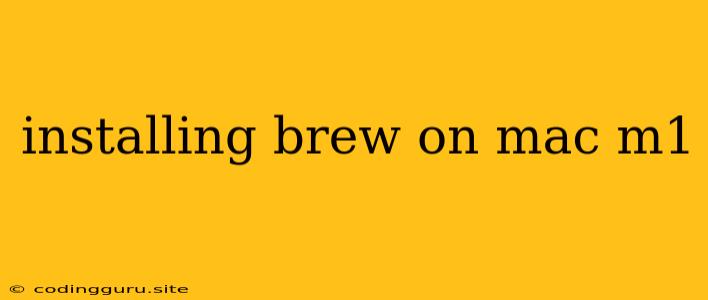Installing Brew on Mac M1: A Comprehensive Guide
The Homebrew package manager is a powerful tool for any Mac user. It simplifies the process of installing software and tools, making it easier to manage your system. While it's widely used, installing Brew on a Mac M1 can be slightly different from older Macs. This guide will walk you through the process, ensuring a smooth installation.
What is Homebrew?
Homebrew is a free and open-source package manager for macOS. It allows you to install and manage software on your Mac easily. Instead of downloading and installing programs individually, Homebrew provides a centralized platform to install and update them. This eliminates the need to manually configure dependencies and simplifies the management process.
Why Install Brew on a Mac M1?
Installing Brew on your Mac M1 offers several benefits:
- Simplifies Software Installation: Brew eliminates the need to manually download and install software from websites.
- Streamlines Package Management: It provides a centralized platform to manage your installed software, making updates and removals a breeze.
- Access to a Wide Range of Packages: Brew offers access to a vast library of packages, including utilities, developer tools, and popular applications.
- Enhanced System Customization: It allows you to tailor your system by installing and configuring specific software packages.
Installation Steps:
Step 1: Install Xcode Command Line Tools:
Before installing Brew, you need to have the Xcode command-line tools installed. To install these, open Terminal and run the following command:
xcode-select --install
Step 2: Download and Install Brew:
Open Terminal and run the following command:
/bin/bash -c "$(curl -fsSL https://raw.githubusercontent.com/Homebrew/install/HEAD/install.sh)"
This command will download and execute the Brew installation script, which will install Brew and its dependencies.
Step 3: Verify Installation:
After the installation is complete, run the following command to verify that Brew has been installed successfully:
brew --version
If the installation was successful, this command will display the Brew version.
Troubleshooting:
If you encounter issues during the installation process, here are some common troubleshooting tips:
- Check your internet connection: A stable internet connection is essential for downloading and installing Brew.
- Run the installation script as an administrator: If you're experiencing permission issues, run the installation script with administrator privileges using
sudo. - Update your Xcode command-line tools: Ensure you have the latest version of Xcode command-line tools installed.
- Reinstall Brew: If the installation fails, try reinstalling Brew by following the steps above.
Using Brew:
Once Brew is installed, you can use it to install packages. To install a package, run the following command, replacing "package_name" with the name of the package you want to install:
brew install package_name
You can also use Brew to update, uninstall, and search for packages. To learn more about Brew commands, type:
brew help
Conclusion:
Installing Brew on a Mac M1 provides a streamlined and efficient way to manage software on your system. By following these steps, you can easily install and utilize Brew to access a vast library of packages and customize your Mac experience. Remember to use the command line effectively and explore the full potential of Homebrew to enhance your workflow.
